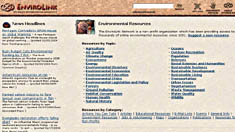|
by Lynda Scarrow
 Cultural
Profiles Project Cultural
Profiles Project
www.settlement.org/cp
One of the more aesthetically pleasing of the federal government's web
sites, the Cultural Profiles Project is part of Citizenship and Immigration
Canada's host program, which funds non-profit organizations to recruit
Canadian volunteer hosts and match them with new immigrants.
Because the site provides volunteers with information about the country
the new immigrant is coming from, it includes a wealth of cultural information
for approximately 104 countries.
 Environment
Canada's Green Lane Environment
Canada's Green Lane
www.ec.gc.ca/environment_e.html
On the opposite end of the aesthetic scale, Environment Canada's Green
Lane is a plain, basic site with a ton of information on environmental
issues.
If you are looking for Canadian-specific charts, facts or statistics
on air pollution, climate change, ecosystems, relevant legislation, nature
and wildlife, waste management and more, this is an excellent place to
begin.
 The
UN for Kids, Youth and Educators The
UN for Kids, Youth and Educators
www.unac.org/learn/wrld/what.htm
The UN for Kids, Youth and Educators site offers a Teacher's Toolbox
and curriculum guides. Another section called What Kind of World? (created
by the Canadian International Development Agency) provides lesson plans
and handouts.
A special section called the United Nations Cyber School Bus - my favourite
part of the site - is available in six languages. Topics include: peace
education, poverty, teaching units on landmines, human rights, cities
of the world, world hunger and indigenous peoples.
The site is loaded with webcasts and you'll definitely want to visit
the Peace Flag Project and the gallery for the Pictures of Peace (a collection
of artwork contributed by students inspired by the UN Peace Poem).
Teachers are also invited to review site content plus test site activities
and receive free classroom materials for participating.
 UNICEF:
Voices of Youth UNICEF:
Voices of Youth
www.unicef.org/voy
"More than 121 million children are not in school today - 65 million
are girls. What do you think needs to be done for every child to be able
to go to school?"
So begins UNICEF: Voices of Youth, a site dedicated to the rights of
youth and children around the world.
Here, you'll find information on child protection, girls' education, HIV/AIDs,
immunization and sustainable development.
The teacher's resource section includes information that may be useful
to educators who teach children affected by war. The strongest part of
the site is Children and Youth Speak Out where children around the world
comment on issues that affect them.
 An
End to World Hunger: Hope for the Future An
End to World Hunger: Hope for the Future
library.thinkquest.org/C002291/high/index2.htm
This simple to navigate site is good for information on historic famines,
present circumstances and future options for dealing with hunger.
The site includes a map showing where world famine is taking place, along
with detailed statistics for each highlighted country, and has a separate
area featuring general world hunger facts and statistics.
Each section also has an interesting issue response area where reader
comments have been posted. The nice thing about this site is that, while
it may appear as if you've uncovered everything very quickly, it has multiple
layers of information.
 Oxfam
Cool Planet for Teachers Oxfam
Cool Planet for Teachers
www.oxfam.org.uk/coolplanet/
A number of international organizations have beautifully designed web
sites chock full of solid information on global issues.
Oxfam Cool Planet for Teachers (there's also an Oxfam Cool Planet for
Children) provides a variety of teacher resources, including a curriculum
for global citizenship, suggestions for teaching students about distant
localities and a section called school linking and twinning.
You can also access an extensive photo library.
Enviro Link
www.envirolink.org/
 If
you're looking for a site that provides comprehensive, international environmental
information, Enviro Link fills the bill. It covers 30 environmental topics
and includes layers upon layers of information. Each of the 30 topic categories
includes a section dedicated to educational resources. If
you're looking for a site that provides comprehensive, international environmental
information, Enviro Link fills the bill. It covers 30 environmental topics
and includes layers upon layers of information. Each of the 30 topic categories
includes a section dedicated to educational resources.
For example, under Air Quality, you will find 194 air pollution and 28
educational links. Consisting mainly of a well-organized, easy-to-navigate
compilation of links, the site also contains a news section and discussion
forum.
 The
Rainforest Alliance Learning Site: Connecting Kids to Conservation The
Rainforest Alliance Learning Site: Connecting Kids to Conservation
www.rainforest-alliance.org/programs/education/index.html
This handsomely designed site has lesson plans on the rain forest for
kindergarten, first, second, third/fourth, fifth/sixth grades.
The site also includes slide shows separated into the same grade categories
that can be shown using a computer and projector.
The Rainforest Alliance home page (www.rainforest-alliance.org/)
provides good additional information for teachers and older students.
 World
Rainforest Information Portal World
Rainforest Information Portal
www.rainforestweb.org/
Another well-designed portal to rainforest links, the World Rainforest
Information Portal includes a good library of map links and a section
devoted to data and research.
The "What can I do to help?" section contains information on
conscious consuming, green transportation and direct action. Information
is suited to older students and teachers.
One nice feature is the "Protect an Acre Program" where a
school could raise funds to protect an acre or more of rainforest.
Lynda Scarrow is the College's web editor. She can be reached at lscarrow@oct.ca.
|

